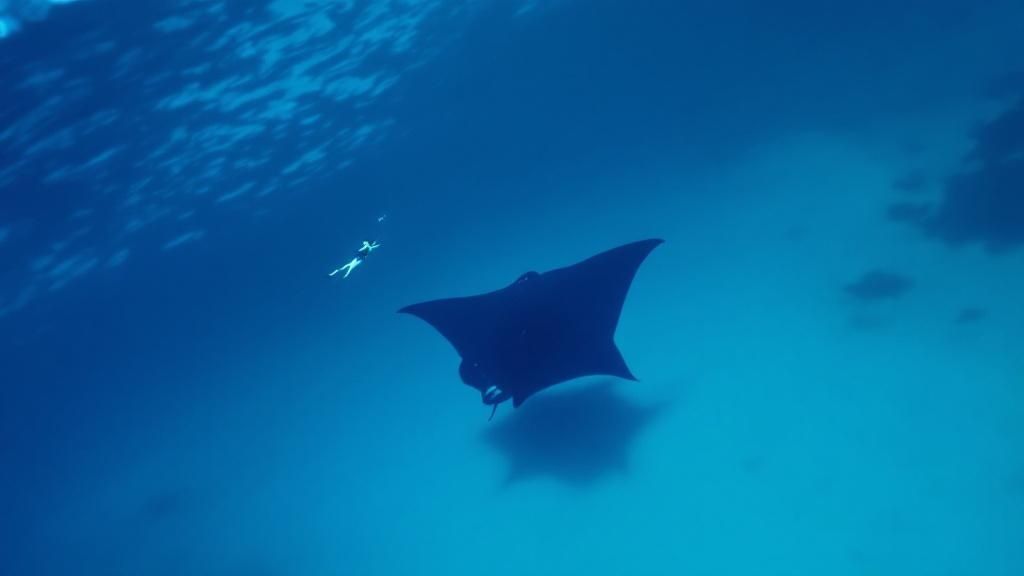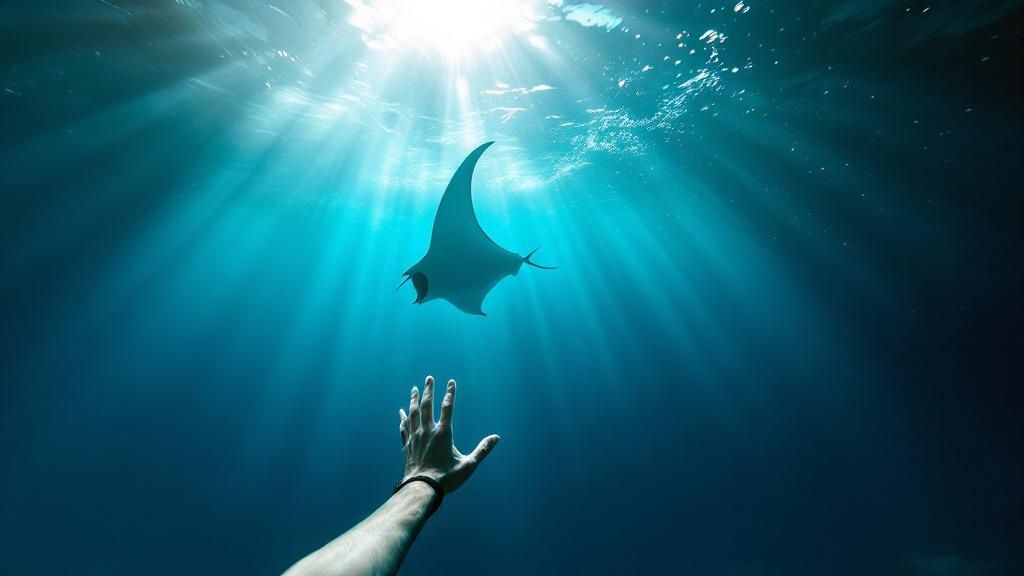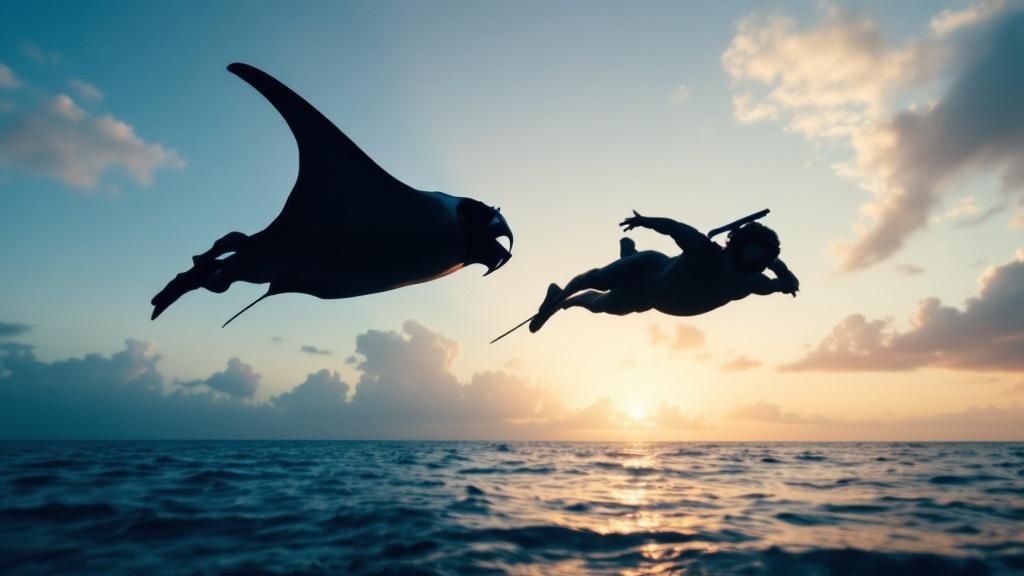Manta Ray Snorkel Big Island: Ultimate Guide & Tours
- Byron
- Aug 13
- 11 min read
Picture this: you're floating in the warm, dark waters of the Pacific, the stars are out, and just inches beneath you, giant, gentle shadows are gliding through the water. It’s like watching a silent, underwater ballet. This is the manta ray snorkel on the Big Island—an absolutely magical experience that, trust me, you’ll want at the very top of your Hawaii bucket list. This guide to the manta ray night snorkel will tell you everything you need to know.
As you can see from the reviews for Manta Ray Night Snorkel Hawaii, this is a can't-miss experience:
Your Unforgettable Manta Ray Encounter in Kona

There's a reason the Kona coast is world-famous for this. It's one of the most reliable and genuinely awe-inspiring marine encounters you can have anywhere on the planet. Here’s how it works: just after sunset, experienced boat captains take you to very specific spots. They then shine powerful lights into the water, which attracts clouds of plankton—the manta rays' favorite food.
This floating feast is basically a dinner bell for the ocean's gentle giants.
You'll float on the surface, holding onto a specially designed light board that gives you a front-row seat to the whole show. But you don't have to take my word for it. The fantastic reviews for operators like Manta Ray Night Snorkel Hawaii really say it all. They have a stellar reputation for safety and for making sure everyone has an amazing time.
The Gentle Giants of the Kona Coast
The reef manta rays you’ll meet are absolutely magnificent. It's hard to grasp their size until you see them in person—their wingspans can easily reach 12 to 14 feet across.
Despite their size, they move with a grace that is just mesmerizing to watch. The whole encounter happens in fairly shallow water, so you get to spend about 45 minutes or more just watching them swoop and feed. The combination of their size, their elegance, and how close they get makes for a powerful and truly unforgettable experience. To dig deeper, you can learn more about the science behind Kona’s manta ray dives.
This isn't just about seeing wildlife from a distance. You're invited right into their world. The feeling of a massive manta ray gliding silently right under you is something that will stick with you forever. It's a core memory in the making.
When looking for an exceptional alternative for a Manta Ray night snorkel tour, check out Kona Snorkel Trips. They run a great manta ray snorkel and are also well-known for their fantastic Captain Cook snorkeling tour, giving you another great way to explore Kona's underwater world.
Why the Big Island Is a Manta Ray Paradise

So, what makes the Kona coast the absolute best place in the world for a manta ray snorkel on the Big Island? It’s not just a lucky accident. It’s a beautiful blend of geography and biology that sets the stage for a truly incredible natural show. Think of the island’s unique underwater landscape as a massive, all-you-can-eat buffet for these gentle giants.
The secret? It all comes down to plankton. The island's volcanic slopes plunge into the ocean, and when the currents hit these specific underwater formations, they create a natural funnel. This concentrates huge amounts of plankton into very specific areas. For the manta rays, it’s like having their favorite five-star restaurant open for business in the exact same spot, every single night. It’s this reliability that gives you such a fantastic chance of seeing them. You can learn more about what makes this a premier underwater adventure on the Big Island right here.
Kona’s Famous Manta Hotspots
A couple of spots have become legendary for their nightly manta appearances: Manta Village and Manta Heaven. And those aren't just catchy marketing names—they’re shallow, protected bays that naturally trap plankton. Tour boats anchor here and shine bright lights into the water, which supercharges this effect, drawing in even more plankton and, of course, the mantas that come to feast.
Manta Village (Keauhou Bay): Just south of Kailua-Kona, this is one of the classic, most reliable sites to see the mantas.
Manta Heaven (Garden Eel Cove): A bit north of Kona, closer to the airport, this spot is famous for sometimes hosting huge gatherings of feeding rays.
This dependable food source is exactly why the Kona Coast is the global center for manta ray tourism, drawing around 80,000 visitors every year just for this experience. The success rate for sightings is incredible, almost always between 80% and 90%. That kind of consistency turns the manta ray snorkel on the Big Island from a long shot into a very likely reality.
The whole experience works so well because it's built on a natural foundation. The island's geology sets the dinner table, and the mantas, being creatures of habit, just show up to eat. This ecological perfection is what makes Kona a true paradise for manta rays and the people who come to see them.
This unique setup allows for the kind of passive, respectful viewing that a responsible tour is all about. You get to just float on the surface and watch as the mantas go about their nightly routine, giving you a front-row seat to their world without ever getting in their way.
Choosing Your Perfect Manta Ray Snorkel Tour

Picking the right company for your manta ray snorkel on the Big Island is easily the most important decision you'll make. It’s what separates a good trip from a truly profound and safe adventure. The best operators don't just focus on the "wow" factor; they're deeply committed to the well-being of the mantas themselves.
A top-tier operator like Manta Ray Night Snorkel Hawaii really sets the bar high. You'll notice the difference right away with their detailed safety briefings, lifeguard-certified guides, and a strict adherence to sustainable practices. Their stellar reviews are a testament to their passion for creating incredible memories.
Another fantastic option is Kona Snorkel Trips. They run an amazing manta ray night snorkel and are also famous for their incredible Captain Cook snorkeling tour. This gives you a great way to experience more of what Kona’s underwater world has to offer.
Understanding Your Tour Options
Not all manta ray tours are built the same. The biggest difference usually comes down to the boat size, and this choice will really shape your entire evening. It’s like choosing between an intimate acoustic concert and a big stadium show—both are fantastic, but the vibe is completely different.
Smaller boats typically mean a much more personal experience. With fewer people on board, you get more one-on-one attention from the guides. These boats are also usually quicker, getting you to the snorkel site with less travel time, which is great if you're an adventurous type or have been snorkeling before.
On the flip side, larger boats come with more creature comforts. Think on-board restrooms, showers, and more deck space. Their size also makes for a smoother, more stable ride, which can be a huge plus for families with kids or anyone who's a little nervous about being out on the open ocean.
The key is to match the tour to your group's personality and comfort level. Ask yourself what’s more important: a cozy, personalized trip, or the stability and amenities of a larger boat?
To make it even clearer, let's break down the main differences.
Comparing Manta Ray Tour Options
This table helps you compare the key differences between small boat and large boat manta ray snorkel tours.
Feature | Small Boat Tours | Large Boat Tours |
|---|---|---|
Group Size | Intimate, fewer people (6-20) | Larger groups (20-60+) |
Experience | More personal attention from guides | Can feel more crowded in the water |
Boat Amenities | Basic amenities, faster travel time | Often includes restrooms, showers |
Best For | Experienced snorkelers, adventurers | Families, first-time snorkelers |
In the end, both types of tours offer a front-row seat to the manta feeding frenzy. By thinking about these points, you can pick the perfect manta ray snorkel on the Big Island and ensure your night is absolutely unforgettable. Once you know what's right for your crew, booking your spot is simple.
What’s It Really Like to Snorkel With Manta Rays?

So, you’re thinking about taking the plunge. What does a manta ray snorkel on the Big Island actually feel like? Let's walk through the experience, step-by-step, from arriving at the harbor to that quiet boat ride back under a blanket of stars. Knowing what’s coming helps melt away any nerves so you can just soak in the magic.
Your adventure starts with a friendly check-in at the dock where you’ll meet the crew. They'll give you a warm "aloha" and a solid safety briefing. This is really important—they’ll cover everything from how mantas behave to the rules for interacting with them safely and respectfully. You'll also get fitted for your wetsuit and snorkel gear.
Once everyone is geared up, you'll hop on the boat and head out just as the sun begins to dip below the horizon. That boat ride itself is part of the experience, offering incredible views of the Kona coastline painted in the warm colors of twilight.
The Main Event: An Underwater Ballet
When you arrive at the viewing site, the crew gets right to work. They’ll set up a large, floating light board—think of it as a custom-made raft with handles on the sides and powerful lights pointing down into the water. This isn't just for you to hold onto; it's the dinner bell for the manta rays.
These bright lights act like a magnet for tiny, microscopic plankton, which is the mantas' favorite food. The plankton swarm to the light, creating a glowing buffet in the dark ocean that the mantas simply can't resist. Once the feast is ready, it's your turn to slip into the water and find a spot at the light board.
You'll float comfortably on the surface, peering down through your mask into the brightly lit water. And then it happens.
Imagine a silent, graceful ballet performed by gentle giants. Out of the darkness, the mantas appear, gliding effortlessly through the beams of light. They swoop, soar, and perform barrel rolls to scoop up mouthfuls of plankton, often coming within inches of you. It's a truly breathtaking spectacle.
You’ll get about 45 minutes in the water, which is plenty of time to be completely mesmerized by the show. Your guides are right there with you the whole time, making sure everyone is safe and comfortable.
More Than Just Mantas
While the mantas are the star attraction, the Big Island is a paradise for ocean lovers. Many visitors also rave about the crystal-clear waters of Kealakekua Bay, which you can explore on a Captain Cook snorkeling tour to see vibrant coral reefs and tons of fish. It’s this dedication to incredible ocean experiences that makes Kona so unique.
The local manta population is also one of the most studied in the world, which helps ensure these tours are sustainable. Researchers have identified over 450 individual manta rays along the Kona Coast, giving us amazing insights into their lives and how to protect them. You can read more about the extensive manta ray research in Kona to see the science behind the magic.
For an even more detailed breakdown of what to expect, check out our ultimate guide for your manta ray adventure.
Getting Ready for Your Manta Ray Snorkel
A little preparation goes a long way in making your manta ray snorkel on the Big Island a truly incredible memory. The good news? It’s pretty simple. A few key steps will have you set for a smooth and comfortable trip.
The single best thing you can do is show up ready to get in the water. That means wearing your swimsuit under your clothes. It just makes everything easier and saves you from a clumsy change on a rocking boat. You'll also be glad you brought a towel and a warm change of clothes—think a sweatshirt or a light jacket. Even in paradise, the night air can feel surprisingly brisk after a swim.
What to Bring and What to Leave Behind
Tour operators have this down to a science. They’ll provide almost everything you need for the snorkel itself. This includes high-quality wetsuits, which are a game-changer. They keep you warm in the cooler night water and also add buoyancy, helping you float with very little effort. Of course, all the essential snorkel gear like your mask and snorkel will be provided and fitted by the crew to make sure it's just right.
So, you get to pack light! Here’s a quick rundown of what you should have with you:
Swimsuit: Wear it to the boat so you're ready to go.
Towel and Dry Clothes: Essential for staying warm and cozy on the ride back to shore.
Motion Sickness Medication: If you're even a little prone to seasickness, it's a good idea to take something beforehand. Better safe than sorry!
Reusable Water Bottle: Always a smart move to stay hydrated.
Pro Tip: Leave the valuables at your hotel. Things like nice jewelry, a lot of cash, or electronics you don't absolutely need are best left on dry land. The less you have to keep track of, the more you can relax and soak in the magic of the moment.
Following these simple tips will have you feeling totally prepared for the adventure. If you want to dive a little deeper, check out these 10 Manta Ray Snorkel Tips for an even more detailed look at what to expect.
Protecting the Mantas Through Responsible Tourism
Swimming with manta rays on the Big Island is a privilege, not just an activity. When you slip into that dark water, you're entering their world, their dining room. This incredible opportunity comes with a responsibility to make sure these gentle giants can thrive for years to come. The whole experience is designed around being a quiet, respectful observer.
The golden rule is beautifully simple: look, but never touch. Manta rays have a special, protective slime coat covering their bodies. It’s like their version of skin, a natural shield against bad bacteria and infections. Any contact from us—even an accidental brush—can strip away that delicate layer and leave them exposed to harm.
Sticking to Manta-Safe Practices
The best tour companies aren't just taking you for a swim; they're acting as guardians for the mantas. They follow strict, established guidelines to keep every encounter safe for the animals and for you. These aren't just suggestions, they are the foundation of a sustainable and magical experience.
Here’s what you can expect:
You'll Stay on the Surface: Everyone holds onto a large, floating light board. This keeps the group together and, more importantly, prevents anyone from diving down and getting in the way of the feeding mantas.
Lights Shine Straight Down: The crew strategically aims the lights to create a concentrated beam, like a spotlight on a stage. This attracts the plankton into one area, letting the mantas feed efficiently without being blinded or confused.
Be a Passive Observer: This is the best part. You just float and watch the show. Chasing or trying to pet the mantas is a huge no-no, as it can stress them out and disrupt their natural behavior.
When you choose a tour that strictly follows these rules, you become part of the conservation effort. Your choice directly supports the well-being of Kona's beloved manta ray population, ensuring this breathtaking experience will be around for others to enjoy.
Have a Few Questions About Your Manta Ray Snorkel?
Getting ready for your manta ray snorkel on the Big Island is exciting, but it’s totally normal to have some last-minute questions. Let's clear up a few common ones so you can feel completely prepared for this incredible adventure. We love seeing our guests' faces light up, just like the ones you see in the reviews for Manta Ray Night Snorkel Hawaii.
Is there a best time of year to see them? Here’s the great news: manta ray snorkeling in Kona is fantastic all year long! Our local manta population sticks around, so they don’t migrate. This means you have a remarkably high chance—over 85-90%—of an amazing encounter no matter which month you visit.
Is this safe for kids or people who aren't strong swimmers? Absolutely. The experience is designed with safety as the top priority. You'll hold onto a large, sturdy flotation board the whole time, and the wetsuit provides extra buoyancy. You can just float comfortably and enjoy the show happening right below you.
What if we don't see any mantas? While it’s very uncommon, nature can be unpredictable. That's why top-notch operators like Kona Snorkel Trips usually have a "manta guarantee." If the mantas don't show, you can typically rebook for free on another night, depending on availability.
Snorkeling vs. Diving: What’s the Difference?
A lot of people ask whether it's better to snorkel or dive with the mantas. It really just comes down to the perspective you want.
Snorkelers get a bird's-eye view, floating on the surface and looking down as the mantas perform their beautiful underwater ballet just inches away. Divers, on the other hand, sit on the ocean floor and look up, watching these gentle giants soar above them like something out of a movie.
Snorkeling is the go-to for most people. It's accessible to almost everyone, doesn't require any special certification, and gives you a spectacular, front-row seat to all the action. It's truly the perfect choice for families and first-timers who want an unforgettable night with these magnificent creatures.
Ready to book your spot for this amazing underwater show?
Comments